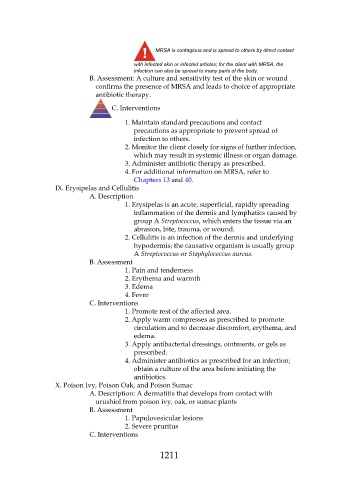Page 1211 - Saunders Comprehensive Review For NCLEX-RN
P. 1211
MRSA is contagious and is spread to others by direct contact
with infected skin or infected articles; for the client with MRSA, the
infection can also be spread to many parts of the body.
B. Assessment: A culture and sensitivity test of the skin or wound
confirms the presence of MRSA and leads to choice of appropriate
antibiotic therapy.
C. Interventions
1. Maintain standard precautions and contact
precautions as appropriate to prevent spread of
infection to others.
2. Monitor the client closely for signs of further infection,
which may result in systemic illness or organ damage.
3. Administer antibiotic therapy as prescribed.
4. For additional information on MRSA, refer to
Chapters 13 and 40.
IX. Erysipelas and Cellulitis
A. Description
1. Erysipelas is an acute, superficial, rapidly spreading
inflammation of the dermis and lymphatics caused by
group A Streptococcus, which enters the tissue via an
abrasion, bite, trauma, or wound.
2. Cellulitis is an infection of the dermis and underlying
hypodermis; the causative organism is usually group
A Streptococcus or Staphylococcus aureus.
B. Assessment
1. Pain and tenderness
2. Erythema and warmth
3. Edema
4. Fever
C. Interventions
1. Promote rest of the affected area.
2. Apply warm compresses as prescribed to promote
circulation and to decrease discomfort, erythema, and
edema.
3. Apply antibacterial dressings, ointments, or gels as
prescribed.
4. Administer antibiotics as prescribed for an infection;
obtain a culture of the area before initiating the
antibiotics.
X. Poison Ivy, Poison Oak, and Poison Sumac
A. Description: A dermatitis that develops from contact with
urushiol from poison ivy, oak, or sumac plants
B. Assessment
1. Papulovesicular lesions
2. Severe pruritus
C. Interventions
1211

